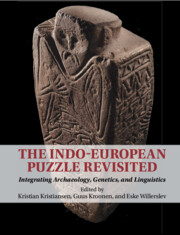Book contents
- The Indo-European Puzzle Revisited
- The Indo-European Puzzle Revisited
- Copyright page
- Contents
- Figures
- Tables
- Contributors
- Preface
- Introduction
- Part I Early Indo-European and the Origin of Pastoralism
- Part II Migratory Processes and Linguistic Dispersals between Yamnaya and the Corded Ware
- Part III The Cultural and Linguistic Significance of Bell Beakers along the Atlantic Fringe
- Part IV The Bronze Age Chariot and Wool Horizons
- 14 Relative and Absolute Chronologies of the Chariot Complex in Northern Eurasia and Early Indo-European Migrations
- 15 Indo-European and Indo-Iranian Wagon Terminology and the Date of the Indo-Iranian Split
- 16 Fire and Water: The Bronze Age of the Southern Urals and the Rigveda
- 17 Wool Fibers of the Northern Eurasian Bronze Age: The Cultural and Geographical Contexts
- 18 An Archaeolinguistic Approach to Indo-European Wool Terminology
- Part V Kinship Systems, Marriage, Fosterage, Free, and Unfree
- Concluding Reflections
- Index
- References
17 - Wool Fibers of the Northern Eurasian Bronze Age: The Cultural and Geographical Contexts
from Part IV - The Bronze Age Chariot and Wool Horizons
Published online by Cambridge University Press: 29 April 2023
- The Indo-European Puzzle Revisited
- The Indo-European Puzzle Revisited
- Copyright page
- Contents
- Figures
- Tables
- Contributors
- Preface
- Introduction
- Part I Early Indo-European and the Origin of Pastoralism
- Part II Migratory Processes and Linguistic Dispersals between Yamnaya and the Corded Ware
- Part III The Cultural and Linguistic Significance of Bell Beakers along the Atlantic Fringe
- Part IV The Bronze Age Chariot and Wool Horizons
- 14 Relative and Absolute Chronologies of the Chariot Complex in Northern Eurasia and Early Indo-European Migrations
- 15 Indo-European and Indo-Iranian Wagon Terminology and the Date of the Indo-Iranian Split
- 16 Fire and Water: The Bronze Age of the Southern Urals and the Rigveda
- 17 Wool Fibers of the Northern Eurasian Bronze Age: The Cultural and Geographical Contexts
- 18 An Archaeolinguistic Approach to Indo-European Wool Terminology
- Part V Kinship Systems, Marriage, Fosterage, Free, and Unfree
- Concluding Reflections
- Index
- References
Summary
The transformation of the prehistoric societies of the northern Eurasian Bronze Age is associated with the emergence and spread of not only basic production industries, i.e. agriculture and animal raising, but also related industries. Sherrat (1997) has called this a “secondary product revolution,” accompanied by the implementation of innovative technologies for new products and forms of consumption. In northern Eurasia, the Middle and Late Bronze Age was a period when prehistoric societies underwent complex social and economic transformations. These changes included the introduction of new technologies of wool production and the making of wool fiber, as well as the spread of this technology. The spread of wool textiles in the third millennium BC is associated with the cultures of the South Caucasus (Kvavadze 2016) and the steppe Catacomb culture of the Lower Don region and Kalmykia (Shishlina et al. 1999; 2020). In the Late Bronze Age, at the beginning of the second millennium BC, the area where wool fibers were used included both the forest steppe and the steppe belt of the Early Srubnaya culture, as well as the forest belt of the Central Russian Pozdnyakovo culture; it extended as far as the Andronovo (Alakul, Fedorovo) world of the Trans-Ural region and North Kazakhstan (Orfinskaya & Golikov 2010; Azarov et al. 2016; Medvedeva et al. 2017) (Fig. 17.1).
- Type
- Chapter
- Information
- The Indo-European Puzzle RevisitedIntegrating Archaeology, Genetics, and Linguistics, pp. 275 - 281Publisher: Cambridge University PressPrint publication year: 2023



